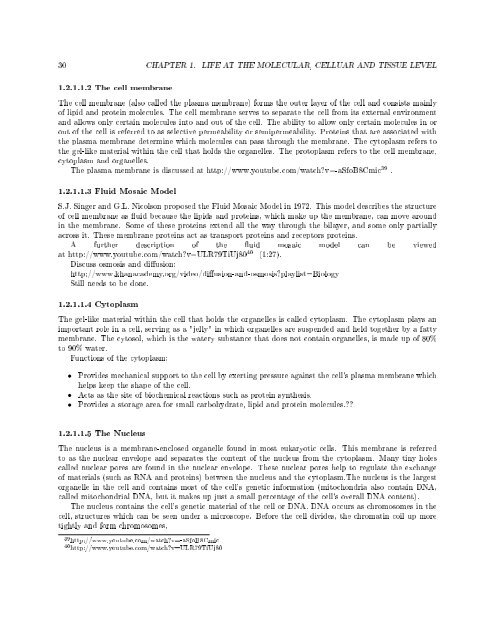Siyavula: Life Sciences Grade 10 - Cd3wd.com
Siyavula: Life Sciences Grade 10 - Cd3wd.com
Siyavula: Life Sciences Grade 10 - Cd3wd.com
You also want an ePaper? Increase the reach of your titles
YUMPU automatically turns print PDFs into web optimized ePapers that Google loves.
30 CHAPTER 1. LIFE AT THE MOLECULAR, CELLUAR AND TISSUE LEVEL1.2.1.1.2 The cell membraneThe cell membrane (also called the plasma membrane) forms the outer layer of the cell and consists mainlyof lipid and protein molecules. The cell membrane serves to separate the cell from its external environmentand allows only certain molecules into and out of the cell. The ability to allow only certain molecules in orout of the cell is referred to as selective permeability or semipermeability. Proteins that are associated withthe plasma membrane determine which molecules can pass through the membrane. The cytoplasm refers tothe gel-like material within the cell that holds the organelles. The protoplasm refers to the cell membrane,cytoplasm and organelles.The plasma membrane is discussed at http://www.youtube.<strong>com</strong>/watch?v=-aSfoB8Cmic 39 .1.2.1.1.3 Fluid Mosaic ModelS.J. Singer and G.L. Nicolson proposed the Fluid Mosaic Model in 1972. This model describes the structureof cell membrane as uid because the lipids and proteins, which make up the membrane, can move aroundin the membrane. Some of these proteins extend all the way through the bilayer, and some only partiallyacross it. These membrane proteins act as transport proteins and receptors proteins.A further description of the uid mosaic model can be viewedat http://www.youtube.<strong>com</strong>/watch?v=ULR79TiUj80 40 (1:27).Discuss osmosis and diusion:http://www.khanacademy.org/video/diusion-and-osmosis?playlist=BiologyStill needs to be done.1.2.1.1.4 CytoplasmThe gel-like material within the cell that holds the organelles is called cytoplasm. The cytoplasm plays animportant role in a cell, serving as a "jelly" in which organelles are suspended and held together by a fattymembrane. The cytosol, which is the watery substance that does not contain organelles, is made up of 80%to 90% water.Functions of the cytoplasm:• Provides mechanical support to the cell by exerting pressure against the cell's plasma membrane whichhelps keep the shape of the cell.• Acts as the site of biochemical reactions such as protein synthesis.• Provides a storage area for small carbohydrate, lipid and protein molecules.??1.2.1.1.5 The NucleusThe nucleus is a membrane-enclosed organelle found in most eukaryotic cells. This membrane is referredto as the nuclear envelope and separates the content of the nucleus from the cytoplasm. Many tiny holescalled nuclear pores are found in the nuclear envelope. These nuclear pores help to regulate the exchangeof materials (such as RNA and proteins) between the nucleus and the cytoplasm.The nucleus is the largestorganelle in the cell and contains most of the cell's genetic information (mitochondria also contain DNA,called mitochondrial DNA, but it makes up just a small percentage of the cell's overall DNA content).The nucleus contains the cell's genetic material of the cell or DNA. DNA occurs as chromosomes in thecell, structures which can be seen under a microscope. Before the cell divides, the chromatin coil up moretightly and form chromosomes.39 http://www.youtube.<strong>com</strong>/watch?v=-aSfoB8Cmic40 http://www.youtube.<strong>com</strong>/watch?v=ULR79TiUj80




![Mum, int. [man] - Cd3wd.com](https://img.yumpu.com/51564724/1/190x134/mum-int-man-cd3wdcom.jpg?quality=85)











